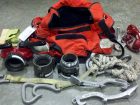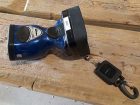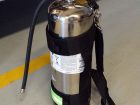
Features
Structural
Training
Back to Basics: November 2016
In my August and September columns we looked at options for securing the standpipe – on the fire floor or the floor below the fire.
November 2, 2016
By
Mark van
Now, let’s consider standpipe operation in terms of equipment; what items are to be brought up to the operations point by the initial responding crew? There are many opinions about the minimum equipment necessary for this type of operation, and these opinions vary based upon the specific situation.
Logically, firefighters working in a highrise or other standpipe-equipped building need to bring the equipment with them. Which equipment goes into the building depends upon the number of initial firefighters assigned and, therefore, available to carry tools and gear. (We will look at the number of firefighters needed for standpipe operations in the next issue.)
So, what equipment needs to be brought into the building?
The highrise hose kit is the most important piece of equipment for standpipe operations; it needs to be in a format that allows it to be easily carried by firefighters and also easily deployed: a floppy hose kit is difficult to carry and control.
The second crucial item is the highrise kit bag (see photo 1). This bag holds items needed to secure the standpipe and to also troubleshoot any problems. A typical highrise kit bag should include:
- 1 2 ½-inch (65 millimetre), 45-degree elbow with pressure gauge
- 1 2 ½-inch (65 mm) 90-degree elbow
- 1 double male coupling (1 ½-inch (38 mm) and 2 ½-inch (65 mm)
- 1 double female coupling (1 ½-inch and 2 ½-inch)
- 1 2 ½-inch (65 mm) x 1 ½-inch (38 mm) reducer
- 1 wire brush
- 1 pipe wrench
- 1 spare wheel for standpipe gate valves
- 2 wood wedges
- 1 hose strap
A forcible entry kit should also be brought to the operations area. This kit holds the Halligan and the flat-head axe, so that a two-person crew can forcibly open any stuck doors. The Haligan can then be used for door control so the door, after being forced open, can be quickly closed, and kept closed until firefighters are ready to make entry with the hoseline. The tools can then be used to aid firefighters who are searching or ventilating the unit or area.
A thermal imaging camera (TIC) (see photo 2), is another item to include. The TIC is useful for locating occupants inside the unit and/or area quickly and for locating the seat of the fire. It can also be used to monitor conditions around the responding crew members, and should be operated by the officer to keep track of personnel and conditions. The TIC can be clipped onto a firefighter’s jacket with a retractable lanyard.
Portable radios are also needed; they are an essential piece of equipment for communication. As the team is separated while doing different tasks, team members will need to be able to communicate and make certain requests, such as asking that the standpipe be charged. If not enough portable radios are available for all firefighters, each team should have at least one radio.
The next essential piece of equipment to carry is a five-pound water extinguisher (see photo 3). This piece of equipment is necessary to provide temporary water application/protection for the search team and fire suppression for the attack team. There may be situations in which a little bit of water is needed to suppress the fire as opposed to a charged handline; for example, a pot-on-the-stove fire or a fire in a garbage can. The water extinguisher will be enough to suppress these types of fires and crews will not have to secure the standpipe.
The extinguisher can also be used by search crews to control or knock back any larger fires. As crews search the unit or area, they may encounter the seat of the fire and with the extinguisher, will be able to keep it controlled until a handline is charged and brought in to complete the job.
The final items that firefighters should carry into a highrise incident are the building keys. Having the keys allows crews to easily access units. Carrying the keys saves time and eliminates the effort necessary to breach locked doors.
Other items that firefighters choose to carry into a multi-storey building will be dictated by the circumstances and situations.
Mark van der Feyst is a 14-year veteran of the fire service. He works for the City of Woodstock Fire Department in Ontario. Mark instructs in Canada, the United States and India and is a local-level suppression instructor for the Pennsylvania State Fire Academy and an instructor for the Justice Institute of B.C. E-mail Mark at Mark@FireStarTraining.com
Print this page


